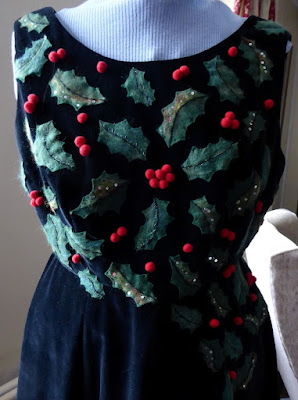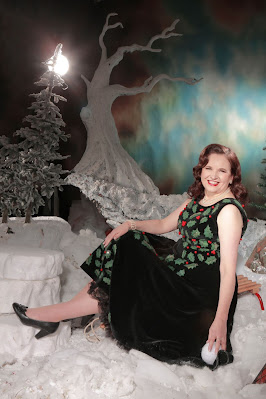You know what? For once I'm not going to lead into this. I'm just putting it right there, at the top of the post.
 |
| Looking ever-so-slightly different |
No, there hasn't been a sudden extreme snowfall in my back yard. And also no, I haven't vastly improved my hair and makeup skills in the last few weeks, either. All will be explained shortly.
I actually finished the dress in the very early hours of Monday morning (
night owl tendencies right there), almost 36 hours before it was needed. Possibly some sort of record.
 |
| Love the glinting sequins in this shot |
As ever, I hadn't kept a tally, but I reckon that I spent about 200 hours working on this dress in total. That's a
lot of hours for one dress. But it all comes down to why I sew. As I've mentioned several times before on this blog, I don't sew because I need more clothes (although being able to create garments which fit is a huge benefit), I do it because I enjoy sewing. I enjoy creating, I enjoy the tactile qualities of working with cloth and thread and, especially over the last two very trying years, being absorbed in a sewing project does wonders for my mental health. But in order to experience these benefits without ending up with a bulging wardrobe, it's necessary for at least some of my projects to be long and labour-intensive ones.
 |
| This is where most of those 200 hours went |
In some ways, having the blog makes this more difficult. Because I'm
posting every week, it's hard to overcome the feeling that there needs to be a steady stream of shiny new toys to maintain interest, rather than progress reports on the same, long, project. But on the other hand, sewing
does take time, and perhaps I should be reflecting that. I'd be interested to hear what readers think - let me know in the comments.
But anyway. A dress which took that long deserves a better record than my usual back-yard-or-indoors-if-wet snaps, and for this I have
Ms1940McCall to thank. She regularly works with professional photographers to create stunning pictures of herself wearing her beautiful forties creations and I discovered that one of these photographers,
Neil Kendall, is based in Chester.
Now much as I don't like having my photograph taken, when you're a vintage dressmaker and you discover that you live literally a ten-minute walk away from an
award-winning vintage photographer well, it seems silly not to take advantage of the situation. In fact, it was Neil's announcement that he was taking booking for shoots on his 'Winter Wonderland' set, complete with hair and makeup by
Bethany Jane Davies, that spurred me into finally starting on my version of the holly dress.
I woke up on the morning of the shoot thinking,
"What. Have. I. Done?", but I needn't have worried. The whole thing was very relaxed. Although Neil and Bethany frequently work with professional models, they were brilliant at putting a complete novice at ease. Bethany, who has won awards for her Old Hollywood hair and makeup, gave me a look entirely in keeping with the mid-fifties provenance of the dress. While the makeup was definitely not an everyday look, I'll certainly be attempting to recreate the hair. Even a couple of days later, people were telling me they loved the style!
Neil meanwhile is a master of old school lighting to recreate that real vintage feel, and also a master at calming nerves and suggesting poses.
Of course, there were some seated shots as well.
 |
| #sewnshownseated |
 |
| Showing the non-leafy side |
It was all entirely new to me, totally out of my comfort zone, and huge fun in what has largely been a fun-free year.
Meanwhile, the practicalities. This has brought my number of
#UseNine2021 makes to the miserable total of three! Family commitments have limited my sewing time this year, but that's still poor.
 |
| Ouch |
I've also only managed to use one of the four fabrics I carried over from last year. The dress actually took 3.5m of the 4.5m remnant, but what's left is too marked and full of weaving faults to be much use, so I'm writing it off, stash-wise.
 |
| Sigh |
But - I'm proud of what I achieved with this dress, and I'm thrilled with the pictures, too, so I'll finish with a final one.
 |
| Worth all the work |
























































